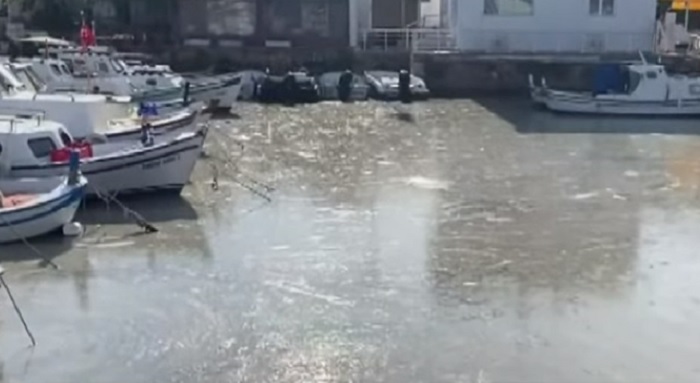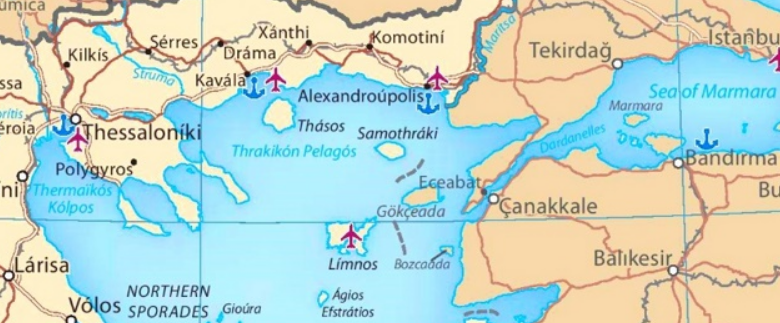
The “sea snot” that has plagued the Sea of Marmaras in Turkey has now infiltrated the shores of the Turkish island of Imvros, posing a serious threat to Greek waters.
Known as Gökçeada in Turkey, the island is positioned in the Northeastern Aegean Sea, at a distance of 14 nautical miles from the entrance of the Dardanelles Strait and 10 and 12 miles respectively from the neighboring Greek islands of Limnos and Samothrace.

The island’s economy is based on fishing and tourism, and the mucus, or sea snot, poses an immediate threat to the survival of the island in an already tricky summer, thanks to the coronavirus. The island is a popular destination for tourism in Turkey.
The mucus is creating an epidemiological crisis for the entire region.
According to scientists, the excessive reproduction of microalgae and plant plankton causes the disgusting mucus, which could even cause an outbreak of infectious diseases, such as cholera.
Sea Snot Will Impact Tourism, Fishing on Imvros
It creates an environment that favors the reproduction of bacteria as it combines excessive reproduction of microalgae and rising sea water temperatures, according to experts.
In a report from CNN Turk, the broadcast reported that there is concern in Imbros about the mucus, since the island is a popular tourist destination in Turkey.
He stated, “Unfortunately, we have grown accustomed to this image in Marmaras for some time now. But the image is not from Marmaras, but from the tourist paradise of the North Aegean, Imvros.
“(Where) the mucus has covered the surface, the sea is not visible,” according to the CNN journalist. And it is now a serious threat as its path is making its way through the Aegean to the Greek islands.
“The mucus has increased its volume. One place that is particularly threatened is the port where the fishing boats harbor,” according to the CNN reporter. Residents of Imvros reported that with the northerly winds days before the mucus approached the island’s shores but continued to travel into Greek waters. The southerly winds brought the mucus back.
The Imvros municipality has already begun cleaning the mucus with crews, while local residents are hoping that the wind will change direction again, so the disgusting mass will not destroy their tourism season.
Fishermen in Kavala have noticed the thick, slimy layer of the mucus-like matter, floating off the coast of the town since April,” marine biologist Kalliopi Pagkou told Greek Reporter in early June.
The sludge collects in their nets, making them so heavy they often break or become lost. The ones that do make it back onto ships are frequently empty, as the strings are coated — making them visible to the fish.
Although the “mucilage,” as scientist term it, is not visible right now in Greek seas, “one cannot predict the future and whether another chunk of Istanbul’s slimy layer will not not move westward,” Pagkou says.
Greek Scientist Explains Sea Snot
The Greek scientist, who is the research director at the Greece’s Institute of Oceanography (IO), says that the marine mucilage is a naturally-occurring green sludge that forms when algae is overloaded with nutrients as a result of hot weather and water pollution.
The creamy, gelatinous substance is generally not harmful in and of itself, but can attract viruses and bacteria — including E. coli — and it can become a blanket that suffocates the marine life in the waters below it.
Marmara sea snot is largest such phenomenon in history
The Marmara Sea sludge is believed to be the largest such formation in history and is causing havoc for local communities.
“The sea snot phenomenon is rare, but not unusual,” Pagkou notes. She recalls huge sea snots forming in the Aegean Sea in the ’80s and the Adriatic Sea in the ’90s.
Pagkou told Greek Reporter that the phenomenon is the result of an overproduction of phytoplankton, caused by the dumping of untreated household and industrial waste in the sea and climate change, as higher temperatures assist in the overproduction of the phytoplankton.
“It is a phenomenon which usually appears in shallow seas or enclosed seas, such as Marmara. This time, however, it took gigantic proportions due to human activity,” she explains.
Boats traveling through the Sea of Marmara have to navigate the grey sludge, and some fishermen are being prevented from working as it clogs up their motors and nets.
Divers have reported that large numbers of fish and other species are dying from suffocation.
See all the latest news from Greece and the world at Greekreporter.com. Contact our newsroom to report an update or send your story, photos and videos. Follow GR on Google News and subscribe here to our daily email!



